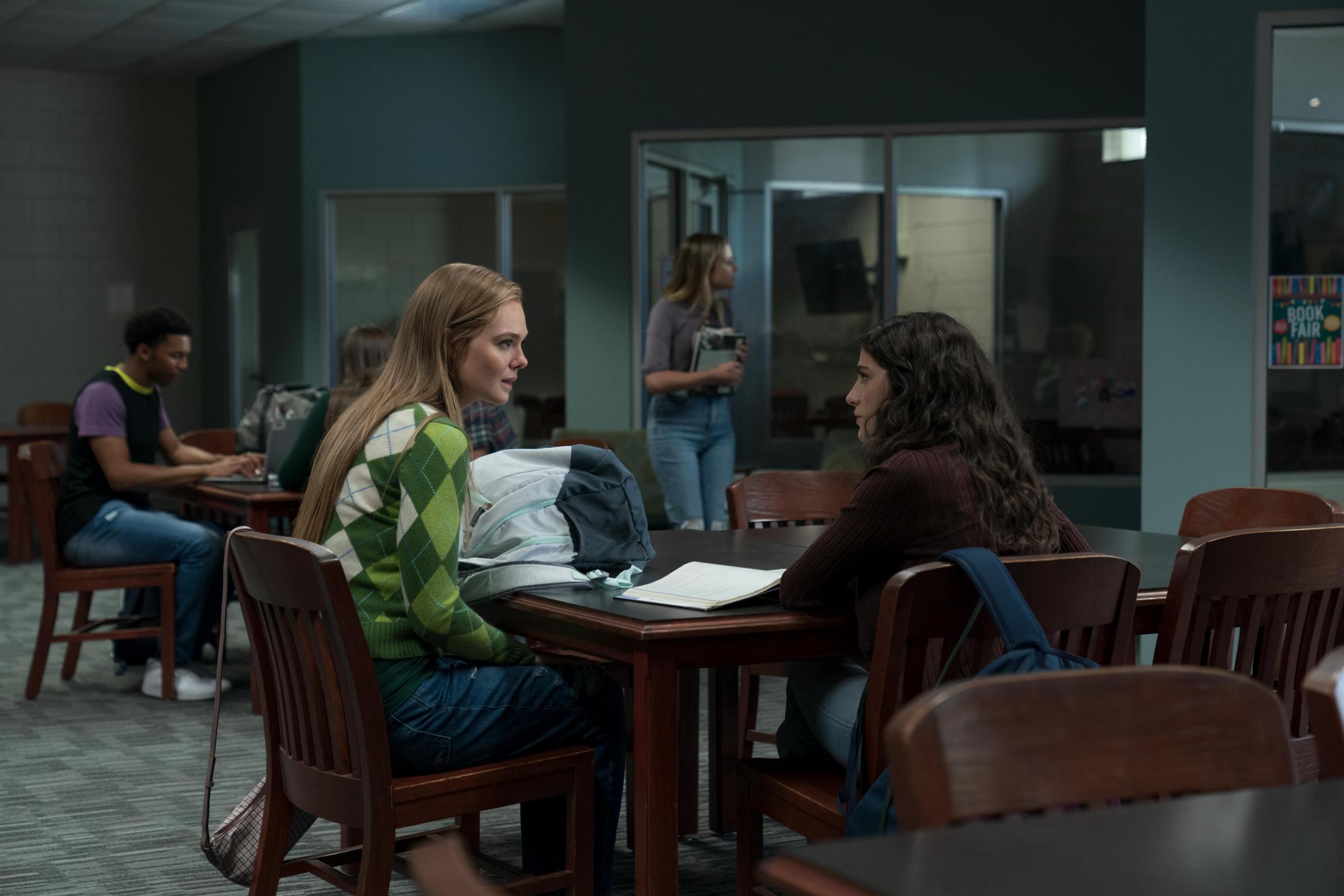Warning: This story contains spoilers for The Girl From Plainville
Liz Hannah and Patrick Macmanus, the creators of the Hulu limited series The Girl From Plainville, out March 29, knew they had to handle the true story of Michelle Carter’s unprecedented “texting-suicide” case with care. “One false moment could ultimately do some real damage,” Macmanus, who also created the Peacock series Dr. Death, tells TIME. “It was our responsibility to not sensationalize this story and to adhere to the truth as much as we could.”
The series, which is an adaption of Jesse Barron’s 2017 Esquire article of the same name, looks at the 2017 case in which Carter was found guilty of involuntary manslaughter in the death of her boyfriend Conrad “Coco” Roy III over text messages that, prosecutors argued, seemed to encourage the teen to kill himself. Notably, Carter admitted in texts that she was on the phone with him in the moments before his death and could have stopped him, but instead told him to “get back in” his truck as it filled with exhaust fumes. (She was released from jail in 2020 after serving 12 months of a 15-month sentence.)
Hannah, a writer on Hulu’s The Dropout, said she came to the headline-grabbing story with “a very preconceived notion and bias towards” Carter, who had been “portrayed as a black widow and a villain” by the press. “I very quickly realized how wrong I was, at least in what I knew about Michelle,” she said. “It felt like there was an opportunity to show people what I had learned—that she was a three-dimensional human and there was more to this story.”
In 2019, HBO aired filmmaker Erin Lee Carr’s two-part documentary I Love You, Now Die: The Commonwealth vs. Michelle Carter, which covers Carter and Roy’s complicated relationship and the court case that followed his death. (Carr, along with Barron, were consulting producers on the Hulu show.) The adaptation, an eight-episode series starring The Great’s Elle Fanning, allowed Hannah and Macmanus to take a closer look at who Carter was beyond how she was presented in a much-publicized court case. “Instead of judging her for being opaque and seeming performative as the media had, I felt like she was this intensely lonely girl,” Hannah said. “Her prevailing sense of loneliness provided a jumping off point for the character.”
Here’s how the creators of The Girl From Plainville worked to stay true to the story behind the series.

The Girl From Plainville depicts Michelle Carter and Conrad Roy III’s real text messages
Carter and Roy lived an hour away from one another in Massachusetts, but the teens met no more than five times in their nearly two-year relationship, according to Esquire. Their relationship blossomed over thousands of texts, which filled 317 pages of court documents, and ultimately led the judge (Carter waived her right to a jury trial) to rule that her messages saying things like “What about hanging yourself or stabbing yourself?” and “Why don’t you just drink bleach?,” had fueled her boyfriend’s suicide. The texts also became the “backbone of the show,” according to Hannah. “Anytime someone sees text exchanges between Michelle and Conrad [on screen], those are their own words.”
While the trial focused on Carter’s more troubling texts to Roy, Hannah found that the couple’s exchanges “read like a two-handed journal.”
“They’re very open and very vulnerable; they’re mean to each other and they’re loving,” she says. “Those texts were a huge asset to us because it really kept us honest in our depictions of their relationship, which was so much more complex than how I initially understood it to be.” Using Carter’s own words would help give a fuller picture of who she was before the tragedy, the creators said. “She was just a young woman who really had hopes and dreams and was desperate for people to like her,” Macmanus said. “It bleeds out of her text messages, she just wanted to be liked like so many of us do.”
Michelle Carter’s Glee fandom plays a key role
As the Esquire story noted, Carter had once texted Roy pieces of dialogue from a Glee episode which paid tribute to the late Cory Monteith, who died from a drug overdose in July 2013. As Hannah and Macmanus began reading through Carter’s text messages they found that it wasn’t unusual for her to take lines of dialogue from Glee and make them her own. “For Michelle, the relationship between Glee co-stars Lea Michele and Cory Monteith was in many ways a guiding light for her,” Macmanus said, noting Monteith’s death happened a year to the day of Conrad’s death by suicide. “To step into her psyche, we had to underline her love of the show.”
They did this by creating several surreal musical numbers in which Michelle appears to be the star of her own episode of Glee. “I think it’s really important to approach these kinds of heavy true stories with humanity and with humanity comes levity at times,” Hannah said about the decision to include these lighter moments. But they didn’t want to ignore the darkness that came with Michelle’s obsession with Glee.
The first episode of The Girl From Plainville ends with Michelle standing in front of a mirror, hours after she discovered that her boyfriend had died, rehearsing a monologue from the Glee episode which honors Monteith. The scene, which took more than six hours to shoot, had always been “the anchor of the pilot,” Hannah said. To prepare for the pivotal onscreen moment, Fanning had “a serial killer-like notebook in which she had written down every move that Lea Michele makes in that scene,” Hannah said. “She would rehearse by herself in the mirror because she knew how important it was to the show and her character to get it right.” For Macmanus, it was “a master class in acting that was just hypnotizing to watch.”

Testimony from the key witness in the Michelle Carter case comes with a warning
During the 2017 trial, Dr. Peter Breggin was brought in by Carter’s lawyer as an expert witness who could explain why she might have sent her boyfriend text messages that appeared to encourage him to take his own life. Breggin, a controversial figure, proposed a theory he called “involuntary intoxication,” a legal term which refers to someone being tricked or forced into consuming drugs or alcohol. He testified that Carter had been someone who loved to help people, but after being prescribed the antidepressant Celexa in April 2014, her “helping nature” was “contorted.” He claimed that Carter, under the influence of Celexa, had convinced herself that abetting Roy’s suicide was a form of help.
The judge didn’t find Breggin’s analysis to be credible and ruled that Carter had a duty to act and her failure to do so made her guilty in connection to Roy’s death. In the years since the trial, Breggin’s views on the use of antidepressant medications, specifically in young adults, have been widely disputed. For that reason, the creators of The Girl From Plainville included a note before the episode featuring Breggin’s testimony, urging viewers to seek the advice of their physician if they are struggling with depression, noting the use of medication “is not only appropriate but can be critically lifesaving.”
The creators, who partnered with the American Foundation for Suicide Prevention (AFSP) and included advisories before each episode, which direct viewers to a crisis helpline and website, said it was their responsibility to provide the facts. “We are in the position of telling this story, but we are not in the position of telling people what their healthcare providers should or should not do,” Macmanus said. “This is a story about the Michelle Carter case and every case is special, every person is special. There is help out there for anybody and it comes in lots of different forms. People have to know there’s help out there for them.”
What was Michelle Carter thinking? The Girl From Plainville doesn’t know
From the start of working on the series, Macmanus and Hannah didn’t want to try and guess why Carter had not tried to discourage Roy from taking his own life. Instead, they wanted viewers to come to their own conclusions on whether justice was served in this case—and take a look inward. “Our hope was that people who thought they knew the story, who had made a judgment—and we were in that group—would come away with a deeper understanding or at least a more empathetic understanding of what all the characters are going through,” Macmanus said. “There’s a lot of us in Michelle and the other characters. I truly hope that people come to this show with an open mind and allow themselves to do some self-reflection as they’re judging these people on screen.”
If you or someone you know may be contemplating suicide, call the National Suicide Prevention Lifeline at 800-273-8255 or text HOME to 741741 to reach the Crisis Text Line. In emergencies, call 911 or seek care from a local hospital or mental-health provider.
More Must-Reads from TIME
- Caitlin Clark Is TIME's 2024 Athlete of the Year
- Where Trump 2.0 Will Differ From 1.0
- Is Intermittent Fasting Good or Bad for You?
- The 100 Must-Read Books of 2024
- Column: If Optimism Feels Ridiculous Now, Try Hope
- The Future of Climate Action Is Trade Policy
- FX’s Say Nothing Is the Must-Watch Political Thriller of 2024
- Merle Bombardieri Is Helping People Make the Baby Decision
Contact us at letters@time.com